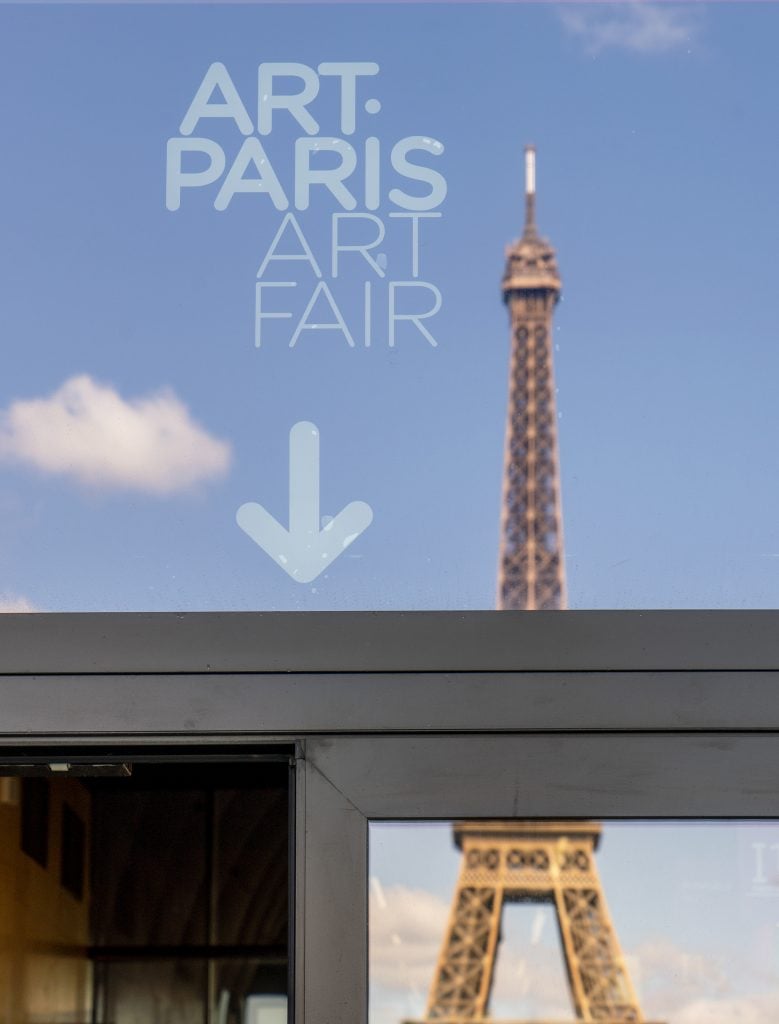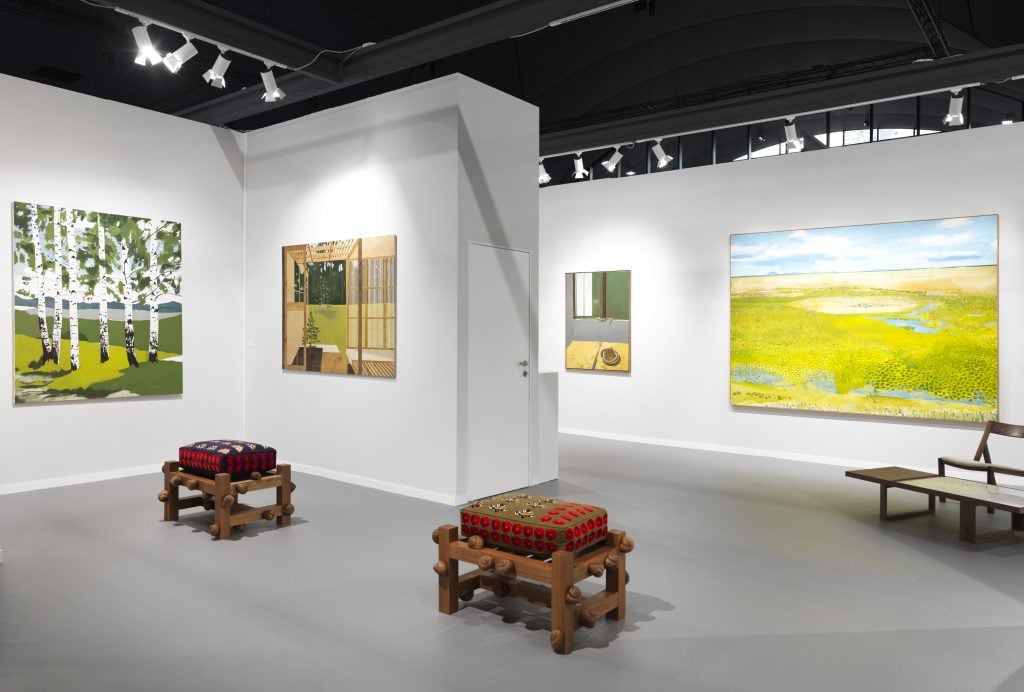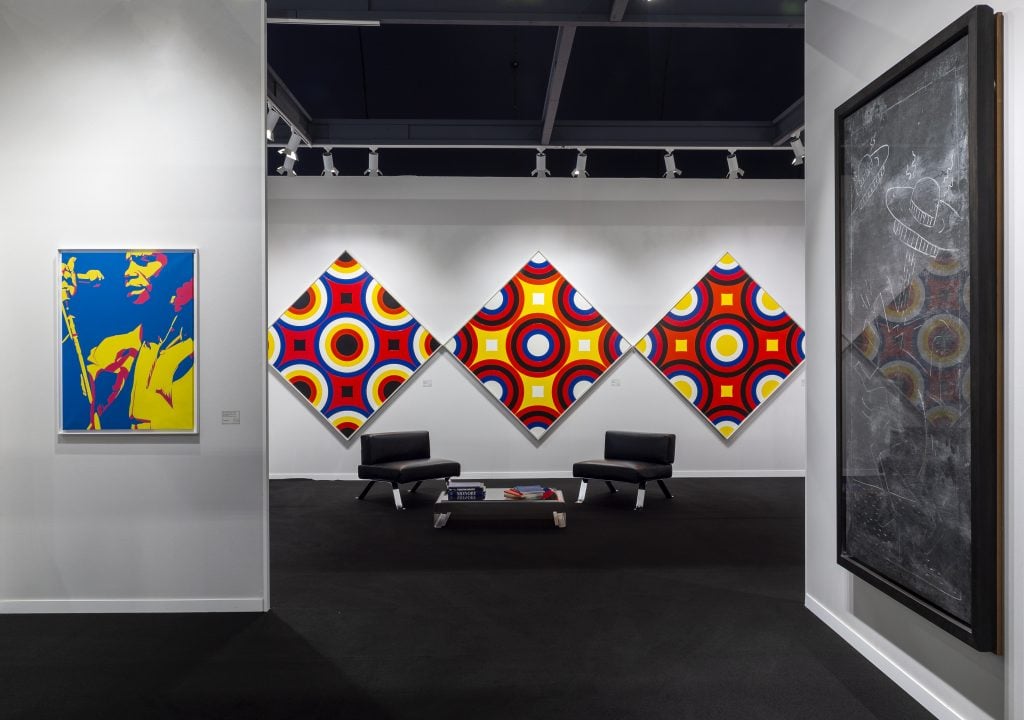Artnet News Pro
As FIAC Exits Stage Left, the Underdog Fair Art Paris Is Finally Getting Its Big Break
Art Basel’s ouster of the regional art fair’s rival has strengthened its position in the market.

Art Basel’s ouster of the regional art fair’s rival has strengthened its position in the market.

Devorah Lauter

A few years ago, few outside of France had heard of Art Paris. But that fact is rapidly changing for the springtime fair, which closed its latest edition on April 10.
After being among the first European art fairs to open in person during the pandemic in the fall of 2020, and the first to inaugurate the temporary Grand Palais Ephémère venue in 2021, the fair has found an additional boost from other major changes in the Paris art ecosystem.
As an influx of international galleries continued to settle in the French capital’s newly booming art scene, art fair titan Art Basel announced in January that it would be moving in as well, in the form of a new event it has since dubbed Paris+. A casualty of war was the historic contemporary art fair FIAC, which Art Basel ousted from its contract with the Grand Palais.
Once seen as somewhat of an “outsider” event by some French commentators, Art Paris is now poised to fill the void left behind by its old rival, known for championing the French scene (though in recent years complaints could be heard that American galleries had begun to replace French dealers at the FIAC), and to play a leading role in a bubbling Paris art sector.

View of Kamel Mennour booth, Art Paris, Grand Palais Éphémère, Paris, 2022. Photo: Archives Kamel Mennour. © Mohamed Bourouissa, Adagp, Paris, 2022. © Maryan Courtesy the artists, the Estate of Maryan, and Kamel Mennour, Paris.
“Art Paris is a great opportunity to bring us together and see art when the fair landscape is completely changing,” gallerist Kamel Mennour, who is participating in the fair for the second time, told Artnet News. Travel restrictions and cancelled events pushed him, along with several other large galleries adding luster to the fair, to participate last year, but he was pleasantly surprised by the results. “There’s a renewed distribution of fairs around the world and in Paris … and this fair helps us take [the art market’s] pulse,” he noted.
This year, other major galleries also returned to Art Paris, including Perrotin, Massimo De Carlo, Galerie Lelong & Co., and Galleria Continua. Significant new arrivals to the 130-exhibitor event included Max Hetzler, gb agency, Denise René, Bernier Eliades, and Rodolphe Janssen. The fair’s director Guillaume Piens said that, since the news of the FIAC/Basel shakeup, several more have requested a slot in next year’s edition, and only a few large galleries who tried the fair last year amid the pandemic shuffle (Almine Rech and Thaddaeus Ropac) opted out this time.
For years, “the difficulty for Art Paris was to find its positioning, because it was a challenger to the FIAC, which doesn’t exist anymore,” said Piens. In addition to jumping at the chance to return to in-person events during the pandemic, in the last five years Piens has focused on promoting the local art scene.
Being a smaller, regional event doesn’t mean without influence, notes the director. “We have a significant regional position, which is our solid foundation, and it was our weapon during the pandemic, but we’re also not completely franco-francais, and we’ve always had a foreign presence,” he said. The trick is finding a balance, which Piens dubs “cosmopolitan regionalism.” It’s a persuasive position that isn’t trying to compete with the globalized one occupied by major international brands like Art Basel.
“There are some galleries who want art fairs to have the whole world present,” said Emmanuel Perrotin in agreement, one of the first blue-chip galleries to join Art Paris in 2020. “But when I’m in Korea, I’m happy to talk to Koreans … At Paris + I’ll be happy to talk to the whole world, but here at [Art Paris] we’re very happy to speak to the French,” he said.

Loevenbruck stand at Art Paris. Photo ©Fabrice Gousset.
The French market is also “more diverse than you think,” said Solene Guiller, co-founder of gb agency, who said her team had spoken “in every language” at their first Art Paris booth. A highlight of the fair, the gallery presented works by Dove Allouche, Tirdad Hashemi in collaboration with Soufia Erfanian, embroidered soap studies by Majd Abdel Hamid, among other artists.
Galerie Lelong & Co. confirmed “the strength of the French collectors and market here,” with buyers from Belgium, Switzerland and France. By the middle of the first day of the fair, the gallery had sold a Fabienne Verdier for €110,000 ($120,000), a Barthélémy Toguo for €60,000 ($65,000), and several David Nash paintings at €6,000 ($6,500), while Galerie Suzanne Tarasiève parted with an installation of cardboard temples by Eva Jospin for more than €100,000 ($109,000) to a French collector.
Meanwhile, Anne de Villepoix sold her entire booth at least twice over, priced €3,000–€45,000 ($3,200–$49,000). “All our French collectors came, but also a lot of foreign collectors and some Americans. We haven’t stopped,” she said. Another newcomer, Rodolphe Janssen gallery from Brussels, sold works by Gert & Uwe Tobias for €5,000 – €45,000 ($5,400–$49,000), and by Thomas Lerooy for about €32,000 ($35,000) to European and American collectors, plus Roger-Edgar Gillet for about €35,000 ($38,000). Young French gallery Pauline Pavec also toasted an “exceptional first day” at the fair, selling works priced €30,000 to €35,000 ($33,000–$38,000) by Jacqueline Lamba, Jacques Prévert, and Mathilde Denize, and Adam Boges to mostly French and European clients.

Richard Taittinger Gallery booth at Art Paris 2022.
For his first fair in Paris, New York-based, French dealer Richard Frerejean Taittinger presented works in dialogue between Paris and New York since the 60s, adding to the modern art on offer. He sold a Keith Haring (€180,000/$196,000), a Warhol print to an LA-based collector for €89,000 ($97,000) and a €95,000 ($103,000) Nassos Daphnis painting. After struggling to build a career in Paris, Taittinger left the city 15 years ago to get his art-world start in New York. Now, he hopes to join the growing art movement towards his native country. The “Paris art scene has changed tremendously since 2007. It’s more global than ever,” he said.
The arrival of Art Basel has further cemented the growing attraction of Paris after years of being snubbed—not unfairly—as an introverted, museum city stuck in the past. But musings about FIAC’s ouster often included concerns: “Paris is no longer able to produce as important a fair as the others. That’s sad, because it’s not logical. We have everything here,” said French collector Véronique Clavière. She is curiously awaiting what Paris + will entail, but like others, was stricken by the toppling of FIAC, a fair Clavière attended as a child. “We are obliged to import something new to restart,” she said.
“It’s almost like we’re orphans,” agreed French collector, Sophie Safar, who feared Art Basel could be “monopolizing” the fair space. “The FIAC was our French fair. It was very specific,” she explained. Nevertheless, she and others felt the switch could bode well for Paris, which has better accommodation than Basel, where “battling” to book a hotel has become a headache, said Safar. Largely for that reason, she may occasionally skip the Basel fair in future. Clavière had also been eager to see whether the pandemic would force real change upon global art fair models, where visitors saw “the same pieces, at the exact same galleries,” she said. “But we’re going back to the beginning,” she said.

Art Paris 2021 © Marc Domage.
Art Paris, at least, hopes to offer something different, right as the Paris scene is taking off in an international way. In fact, Paris + and the more accessible Art Paris “are very complementary,” said Nathalie Obadia, longtime Art Paris participant, who sold works at the fair by Laure Prouvost, Wang Keping, Fiona Rae, Shirley Jaffe, and Guillaume Bresson for €10,000 to €100,000 ($11,000–$109,000). Art Paris has “found its positioning, which is not like Basel or Frieze, but with a strong French identity, where it has artists and galleries you’re not used to seeing in other fairs. For that reason, it has an educational value,” she said.
“Paris is the most important city for art in Europe right now,” said Massimo De Carlo senior director Laura Ravelli, citing the combo of museums, galleries, fashion, and restaurants. The gallery, which opened a space in the Marais last year, was attending Art Paris for a second time. “Since London is not considered Europe now, there’s no other city that compares.”